
Donate to Innerviews
Since 1994, Innerviews has provided uncompromising, in-depth interviews with musicians across every genre imaginable. And it does that with no trackers, cookies, clickbait, or advertising.
Your donations are welcome to help continue its mission of highlighting incredible music and artists, without any commercial considerations.
Your contributions will be instantly transformed into stories and videos, and cover hosting and web management costs. Importantly, your dollars will help ensure Innerviews remains absolutely free to all visitors, independent of their ability to financially support it.
Please consider making a donation today by using the PayPal QR code below.

Okay Temiz
Flourishing Rhythms
by Anil Prasad
Copyright © 2023 Anil Prasad.
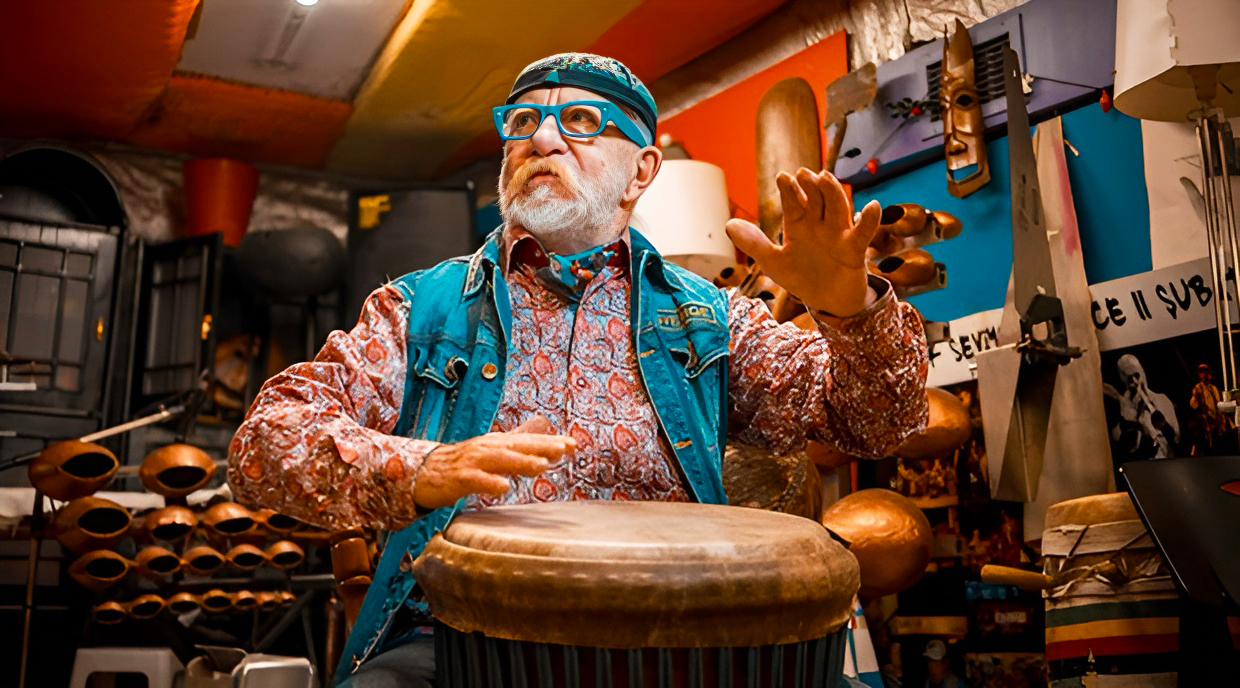 Photo: Okay Temiz Collection
Photo: Okay Temiz Collection
Respect and diversity are two of Okay Temiz’s key operating principles.
The drummer, percussionist, composer, and producer is an icon in his home country of Turkey. He’s a key figure in some of the most important cross-cultural musical projects that combine Turkish music and instrumentation with jazz and other genres and influences from across the world.
Temiz is also an inventor. He has created many percussion instruments, including hand-beaten copper drums, the Artemiz featuring camel and sheep bells, the Magic Pyramid which involves electronics and custom metalwork, and reinventions of the berimbau and water drum that combine centuries-old traditions with modern processing.
Temiz has released dozens of albums under his own name, as well as contributed to countless sessions. The prolific musician has also performed at more than 3,000 concerts and headlined over 350 jazz and world music festivals.
He’s best known for Oriental Wind, a musically borderless group that combines jazz, Turkish, African, and Latin music in an exhilarating way. First formed in 1974, Oriental Wind’s lineups have featured Turkish and European musicians. Some of its notable members have included Roman Bunka, Palle Danielsson, Doudou Gouirand, Thomas Östergren, and Bobo Stenson. The group existed into the mid-‘80s, with occasional rekindlings, including the 2014 album Aurora Borealis, which found him partnering with Aydin Esen as a core presence.
Oriental Wind incorporated many Swedish musicians because Temiz was based in Stockholm for three decades between the ‘60s and ‘80s, before relocating to Finland in 1993, and eventually back to Turkey in 1998. His deep involvement with Sweden and its jazz culture emerged from him visiting it between 1959-1967 as part of dance music groups. In 1967, he broke away from commercial music, joined trumpeter Ulvi Temel’s band, and began playing jazz gigs in Europe. During visits to Stockholm, he encountered Maffy Falay and Don Cherry, both of whom he would go on to collaborate with extensively.
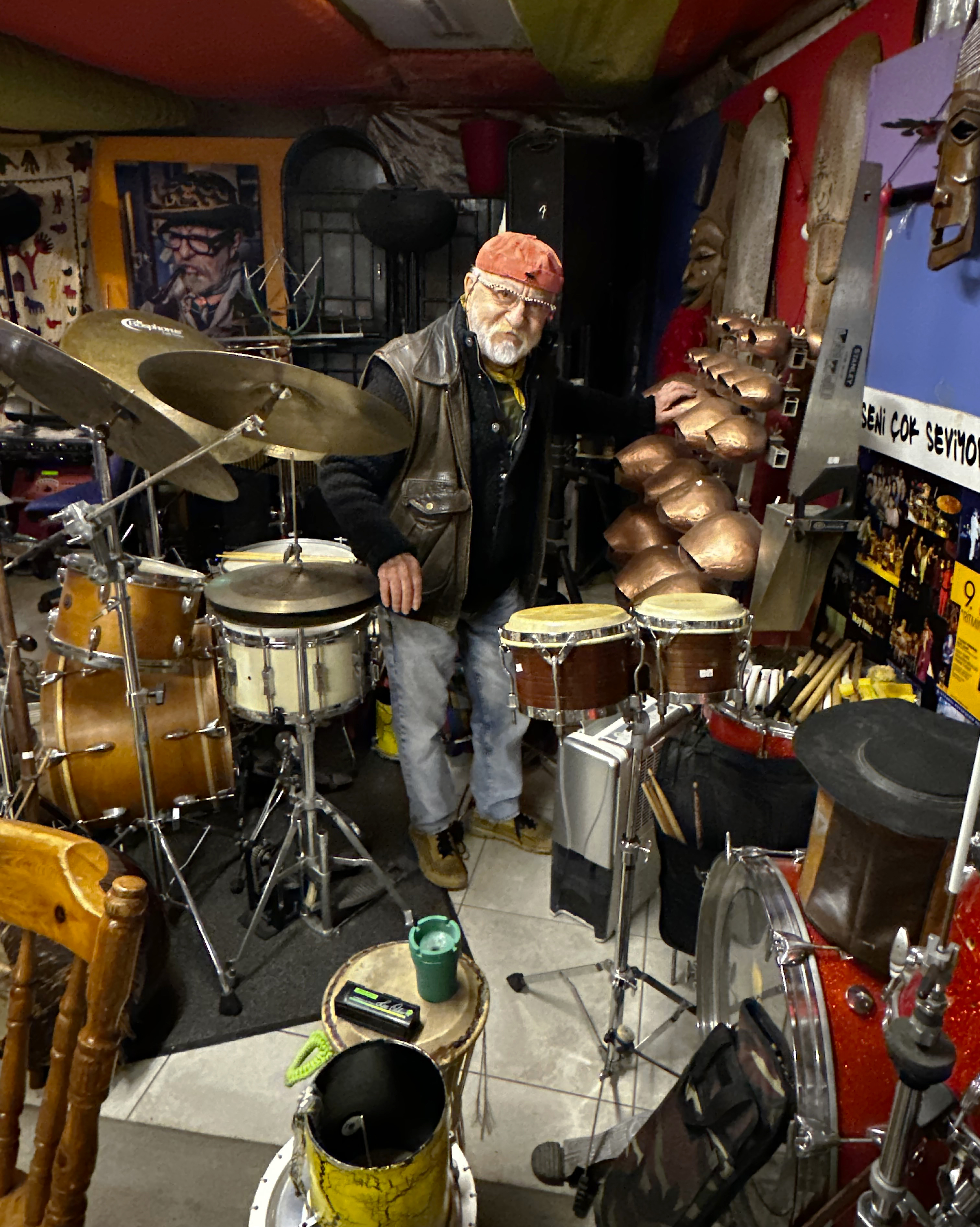 Okay Temiz at Ritm Atölyesi, Istanbul, 2023 | Photo: Anil Prasad
Okay Temiz at Ritm Atölyesi, Istanbul, 2023 | Photo: Anil Prasad
In 1969, Temiz began an enduring musical partnership and friendship with Cherry that lasted until the trumpeter’s passing in 1995. Together, they scaled immense heights across several adventurous multi-genre albums combining jazz, African, Turkish, Indian, Indonesian, and other global influences. Key Cherry recordings Temiz appears on include 1973’s Orient and Organic Music Society, 1974’s Blue Lake, 1978’s Live in Ankara 1969, and 1994’s Dona Nostra.
From 1972-1974, Falay and Temiz joined forces in Sevda, which combined Turkish folk music with Western jazz. The group was known for its pulsating, kinetic rhythmic approach and creative, often long-form arrangements. During this same period, Temiz collaborated with Johnny Dyani and Mongezi Feza, which yielded two revered avant-jazz albums infused with South African influences: 1973’s Music for Xaba and 1980’s Music for Xaba Volume Two. A third recording titled Rejoice was released in 1988. All of the LPs are derived from the group’s late-1972 sessions and performances.
During Temiz’s last 30 years in Turkey, he’s released 20 of his own recordings, including global fusion and orchestral works, as well as engaging in many collaborations. Some of his higher-profile endeavors include working with the Karnataka College of Percussion on 1996’s Indian jazz-fusion effort Mishram; Floros Florides and Nicky Skopelitis in an eclectic jazz-rock trio yielding 2001’s Our Trip So Far and 2010’s Three of a Sort; and Marcus Miller’s 2012 Istanbul Project.
Recently, Temiz has focused on integrating his percussion approach into the output of younger musicians. In 2021, he worked with Belgian producer soFa on a recording titled Şelale. It involved soFa recording Temiz’s performances on his self-created instruments, and building pulsing electronica tracks around them. In 2023, he worked with the eclectic Turkish electronica-oriented act Islandman on its Direct-to-Disc Sessions LP. The upbeat effort combines Temiz’s percussion ideas with its Balearic-inspired DJ approach into a set of percolating, long-form tracks. Notably, all the music was recorded live in the studio, entirely in one take.
Innerviews traveled to Istanbul to meet Temiz at his Ritm Atölyesi school, which translates into Rhythm Workshop. Located in the heart of the city’s Galata district, the establishment brings together musicians from every walk of life and experience level. It’s a large, sprawling, and colorful complex replete with hundreds of percussion instruments, including all of Temiz’s unique creations. The atelier also serves as a studio environment, where Temiz has made many recordings.
The atelier has an electric vibe. One can sense the history and gravitas it represents from the moment one walks into it and gets hit with the sensory overload of seeing all the instruments laid out in the open.
It’s clear the environment revolves around Temiz himself, who holds court as musicians, students, and fans drop in unannounced to say hello. Despite his legendary status, he turns no-one away and ensures everyone gets time with him. In fact, Innerviews had to gently pull him away from an assembled, previously-unannounced crowd to conduct the interview.
At age 84, Temiz cuts an elegant figure. The bearded musician is dressed in a red beret, checkerboard-framed glasses, leather vest, a modern black zip-up sweater, a yellow silk neck scarf, and jeans. He works out multiple times a week and looks like he’s in his mid-sixties. The incongruity of Temiz chain smoking a pipe throughout the conversation, engulfing the atelier in white, cloudy ribbons is a source of intrigue, yet he appears to be a picture of vigorous health.
Temiz is an animated interview subject, communicating with great enthusiasm and reverence for the icons he’s worked with. He frequently gesticulates, making conversational percussion motions to emphasize his expansive and storied perspectives.
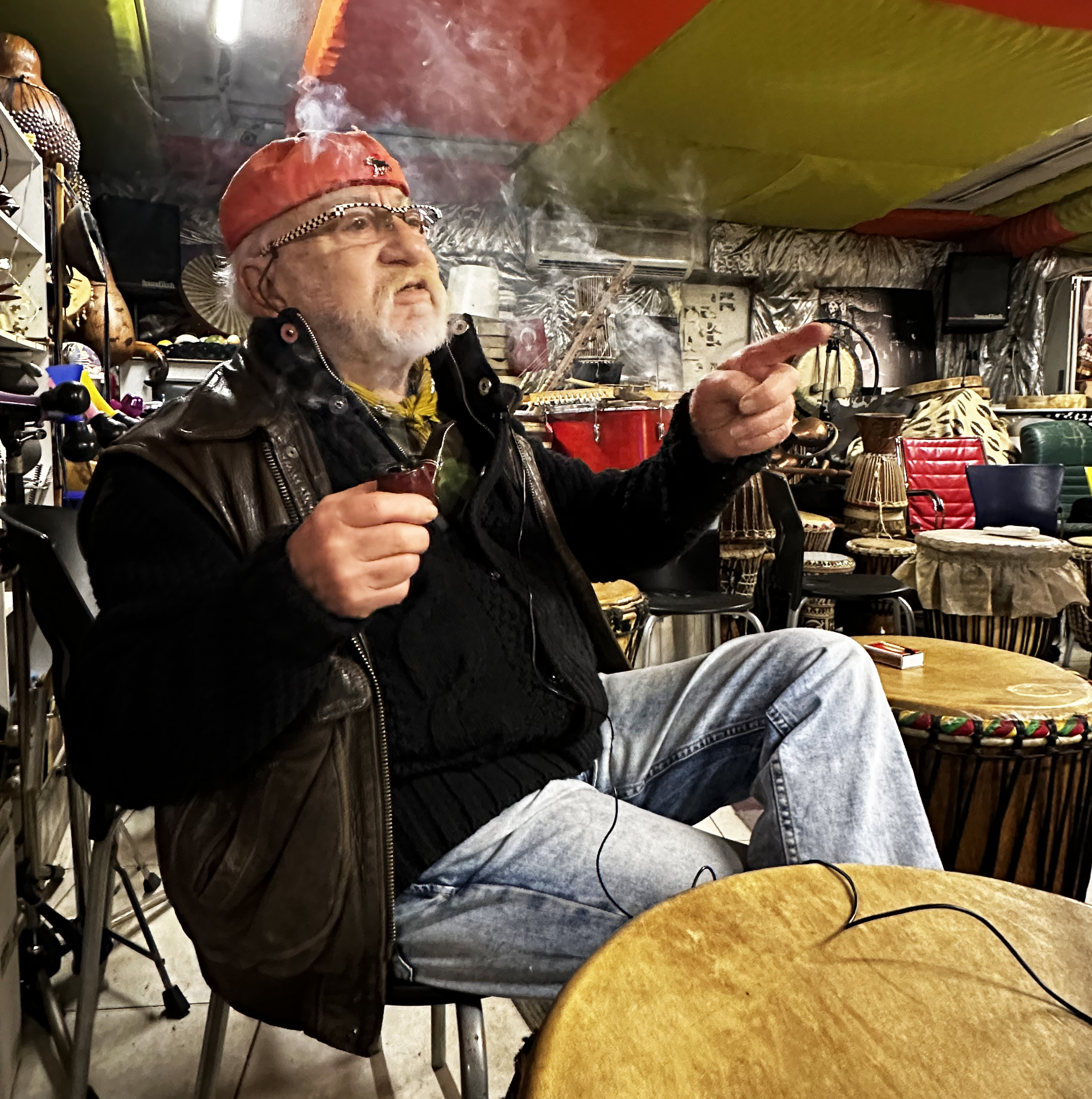 Okay Temiz in conversation with Innerviews, Istanbul, 2023 | Photo: Anil Prasad
Okay Temiz in conversation with Innerviews, Istanbul, 2023 | Photo: Anil Prasad
Tell us about me about your atelier and the people you teach here.
My school is for everyone. Regular people from everywhere come here, including secretaries, doctors, and kids. They come to learn and play. Some of them have never touched drums before in their whole life. Sometimes music teachers come here to learn as well. There are musicians who don’t know the rhythms we explore because they were educated in a very straight way. There are classical musicians who come here to learn new instruments and music. People who come here are open to listen.
When I was coming up in the '50s, people couldn’t listen to jazz in Turkey. Tango was forbidden, too. You could only listen to classical music. Classical musicians don’t learn rhythms from around the world
In India, they say “melody is the mother and rhythm is the father.” Rhythm is a continuous thing. When you are born, a rhythm is born that continues your whole life, and maybe beyond. It’s very important and something I focus on here.
Around the school, you’ll see the instruments I have created. I’ve built many of my own instruments, including electronic ones. I learned how to cut metal and put the pieces together to create instruments that are new and interesting.
You’ve said the most important thing a musician can bring to any situation is respect. Expand on that perspective.
Absolutely, this is true. First, you have to have respect for yourself and what you do. You have to believe in what you know or play. It involves having to think without thinking. Respect for yourself and the musicians you work with is a deep, innate thing. You have to listen first and learn from that listening. It’s 70 percent of what musicians need to do. You cannot succeed without listening, or everything is coming from your ego alone.
I remember making the Music for Xaba albums with Johnny Dyani and Mongezi Feza. The group had one Turkish person and two South Africans. We loved each other. We were very good friends. When we played together, it was so easy, because it was an organic ensemble. We made music without deciding anything in advance. Because we respected each other, there was no problem, and we didn’t need to rehearse.
It was the same with Pharoah Sanders, who I played three concerts with once with no rehearsals. I said to Pharoah in the dressing room, “What are we gonna play?” He said to me “No talk. No show.” What he meant by that is we will listen to each other and that we will play without any showbusiness element. This is a problem the Turkish and European music scenes suffer from. The music itself is the show, not moving around the stage as an actor would.
So many people are focused on music that is easy to play and sell. This music doesn’t reflect the real world. We have a lot of problems in Turkey and so does the rest of the world. The people who make and promote this easy music aren’t using art to educate or help other people through it. It is just entertainment. That is not what I do.
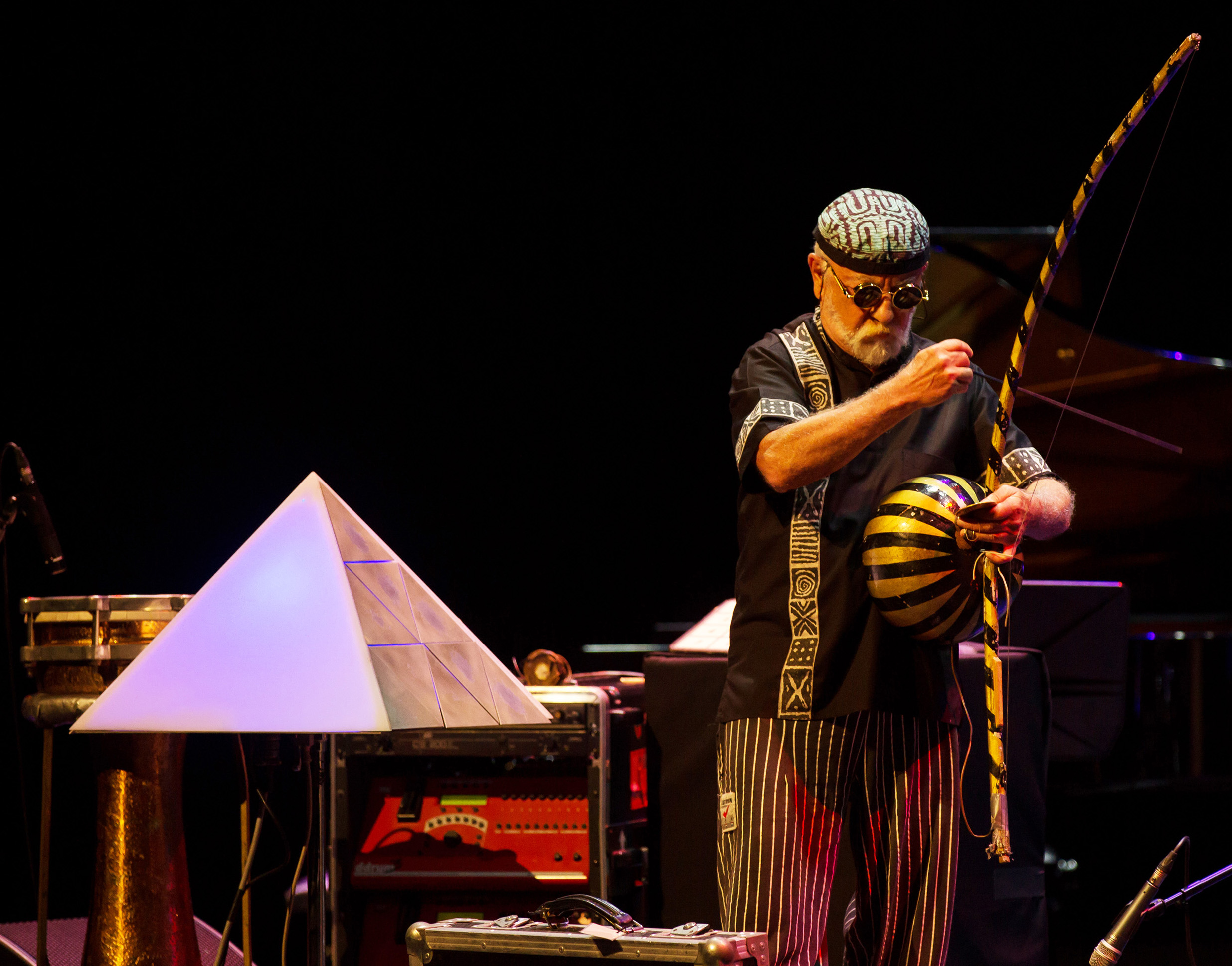 Photo: Caz Müzisyeni
Photo: Caz Müzisyeni
Where did your interest in going beyond Turkish musical constructs emerge from?
For 19 years I played dance music at the troublemaker clubs in Turkey, as well as places like the Hilton and Sheraton hotels. It was very nice music like cha-cha-cha, Cuban stuff, and jazz-style dance stuff. But I did that for too long. What I was really interested in was European jazz.
In Turkey at that time during the ‘50s and ‘60s, the focus was on Oriental music. When I would play Turkish music, I’d play the drums differently, not the jazz way. Sometimes we’d use cymbals, but not always, and not in the rhythmic way of European jazz. I would also play places like Beirut and Libya, and eventually I’d go to places in Europe like Denmark and Sweden with dance orchestras.
When I was in Stockholm with these groups, I saw Maffy Falay, the great trumpet player, perform. He was playing with the Kenny Clarke-Francy Boland Big Band. He was one of the first Turkish musicians to go from Turkey to Sweden to play jazz. I met him the next day after the concert and we discussed his experiences which had a big impact on me.
I also saw Don Cherry perform in Sweden and I met him there. Don was always looking deeply at the music, trying to learn, and change it. He was always searching for another sound. He was very interested in me as a Turkish drummer and Turkish rhythms. He was one of the most important musicians, ever. He explored so many sounds, including Indian, Sufi, Buddhist, and eventually Turkish music. In the ‘70s, Turkish music wasn’t appreciated by most jazz musicians. When I encountered Don, this is when I really started to think about different musical approaches.
The music Maffy and Don were doing in Sweden and the rest of Europe wasn’t being played in Turkey at the time. So, I decided to go to Europe. I spent a lot of time in Sweden, but mostly France. In France, there are more Africans. It’s more cosmopolitan. I would bring some Turkish music with me—7” singles—and try and get the jazz musicians like Don to listen to them. People were familiar with Indian music at the time in the ‘60s, but Turkish music was new to a lot of people.
It was not easy to bring musicians from Turkey to places like Stockholm for concerts. That sort of traveling culture was not established yet for Turkish musicians. But as we moved into the ‘70s, it started to become easier. Don’s interest in what I do was of great help.
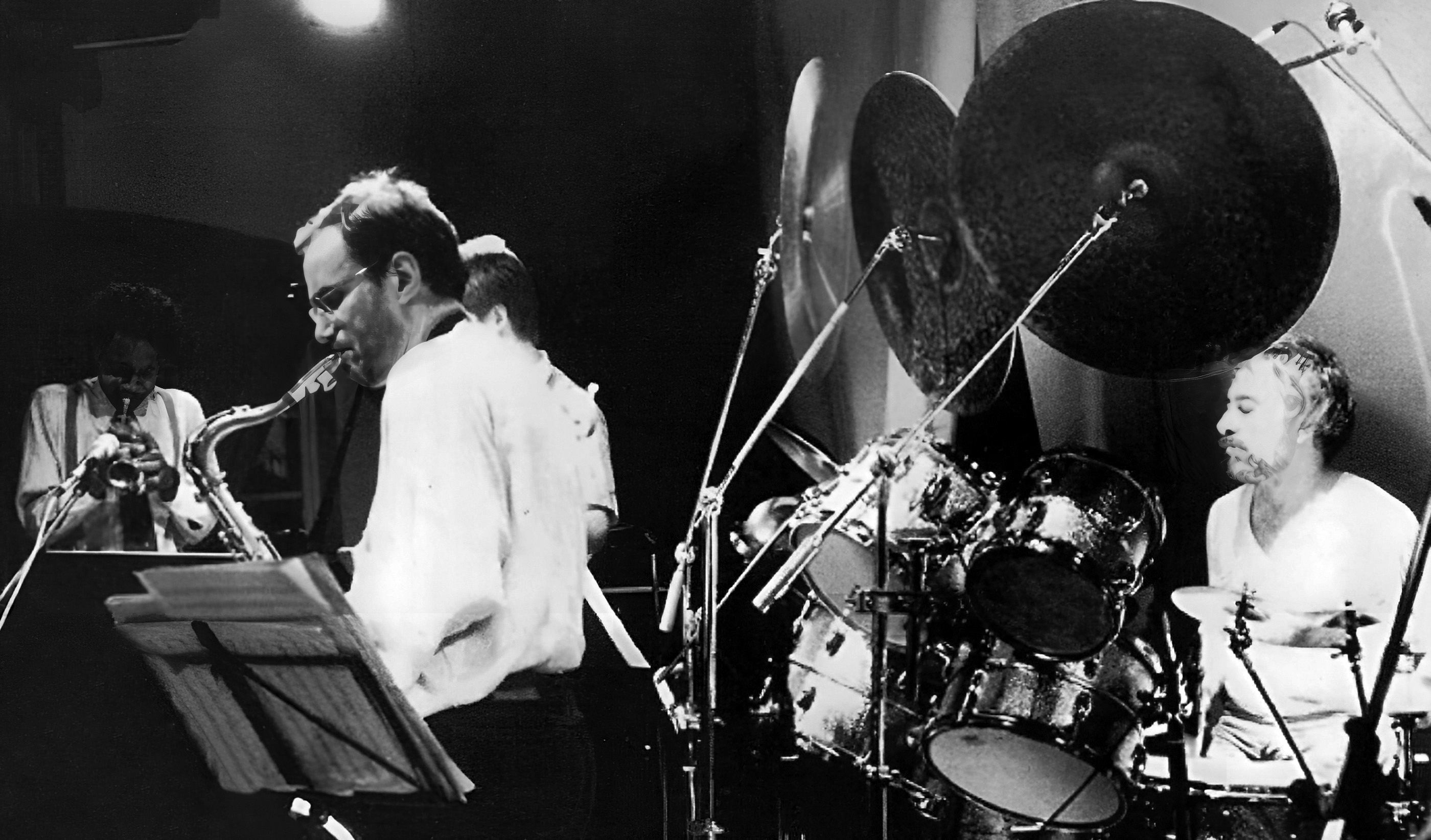 Don Cherry's Dona Nostra band, Oslo, 1993: Cherry, Lennart Åberg, and Okay Temiz | Photo: Okay Temiz Collection
Don Cherry's Dona Nostra band, Oslo, 1993: Cherry, Lennart Åberg, and Okay Temiz | Photo: Okay Temiz Collection
You were part of the band that recorded Cherry’s landmark Live in Ankara recording. Reflect on that experience.
To get to that concert back in November 1969, we traveled 4,000 kilometers from Sweden to Ankara in an old Volkswagen minibus with Don’s wife Moki, and his kids Eagle-Eye and Neneh. I still remember having to stop the minibus once because there were 30-40 lambs blocking the road. Don and I got out and started playing folkloric music for the lambs to get them to move. Then another two guys showed up, who also had flutes and would play folkloric melodies and harmonies. Don was surprised that people would just show up and do that.
When we arrived in Ankara at the U.S. Embassy where we were to play, I told them “Don Cherry is here.” But they didn’t know much about him or us. However, they were respectful, and a very good audience came to the show, and it was full.
Our band had Selçuk Sun on bass and Irfan Sümer on tenor sax. They were very talented guys. Selçuk was a classic bass player and Irfan was someone I played with in dance orchestras. I asked them to do this event.
Don had a lot of big flowers put on the stage, so it felt more like a village home than a stage. It was a very natural, organic concert. It was one of the best Don concerts of the time. The stage was like home for his kids. They’d walk around the stage.
A half-hour before the concert, Don and his family didn’t want to talk with anybody. They would meditate on their own and then when they finished, they’d perform. It was something you had to respect. We did wonder what he was doing on his own, but he used that time to focus, cleanse his mind, and really think about the performance. Today, musicians go to the bar and drink before going on stage. Don’s approach was another way.
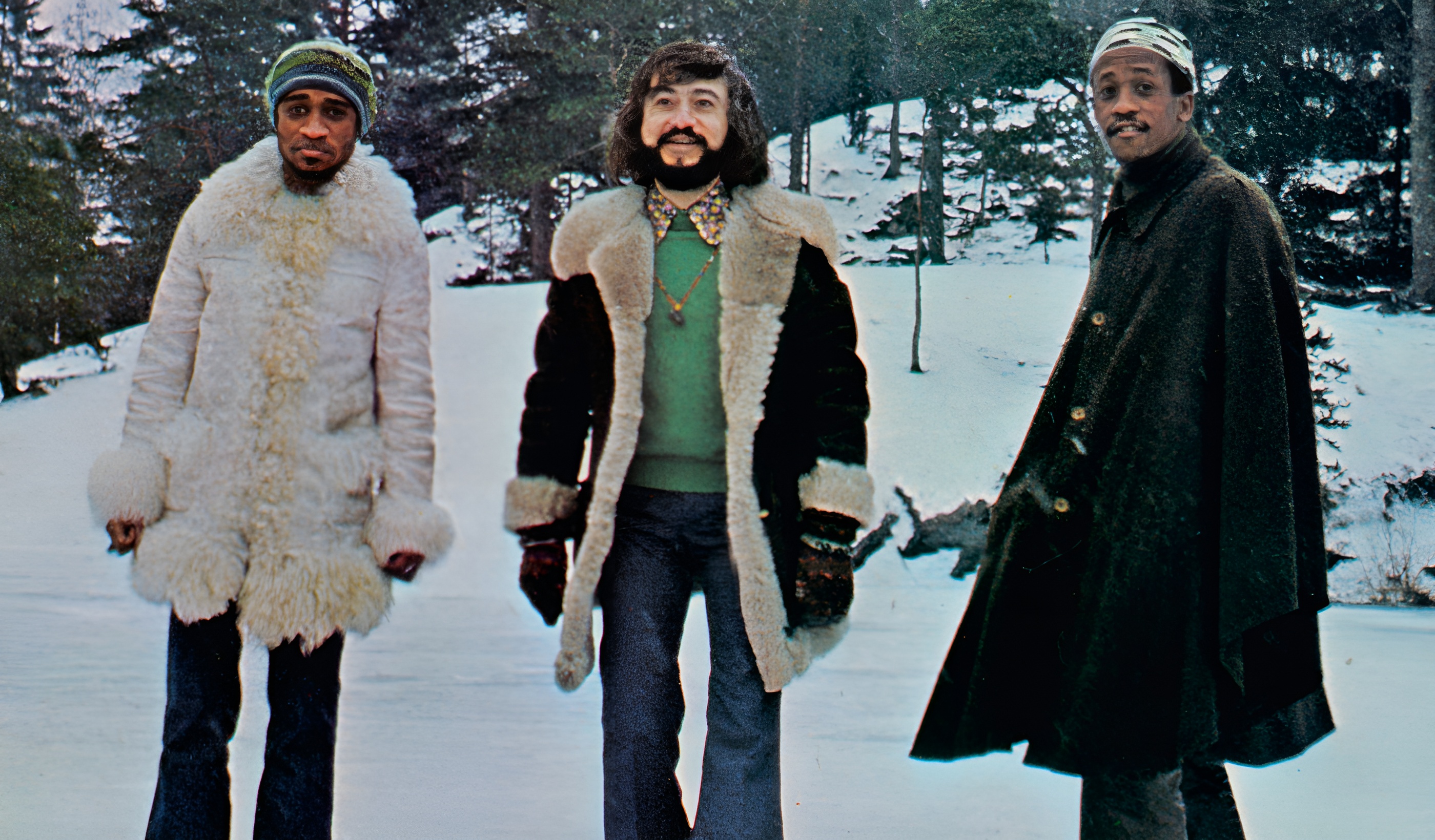 Music for Xaba, Stockholm, 1972: Johnny Dyani, Okay Temiz, and Mongezi Feza | Photo: Rita Knox
Music for Xaba, Stockholm, 1972: Johnny Dyani, Okay Temiz, and Mongezi Feza | Photo: Rita Knox
The Music for Xaba albums were both recently rereleased. What can you tell me about how those recordings came together?
I met Johnny Dyani and Mongezi Feza through Don Cherry. When we started working together, I was living in a small wood house in the jungle when we made the first one in 1972. We practiced there for many hours. I really enjoyed the music we made. It was something very different to my work with Don and Oriental Wind.
The Music for Xaba albums changed the way I played. Johnny would play one line and Mongezi would play other things in response. Music for Xaba goes back to what we were discussing about listening. It was all about listening to each other. No-one was imitating what the other was doing. We were all going different ways in the music and then deciding what each of us had to do to make it all come together. Somehow, we made it work.
I still remember David Murray coming up to me to say he listened to Music for Xaba and understood it and liked it. After that, we became very friendly, and I’d always see him when he came to Turkey.
Provide some insight into the making of your classic Drummer of Two Worlds album from 1980.
I remember when I went to the studio to make it, there was a large room with a grand piano, an organ, and all of my percussion instruments, including copper drums. When I’d touch the piano, I’d see there was a song to make. I also felt I should use the zurna player Ziyaettin Aytekin on it.
Totally different things came out of those sessions, musically. I forgot what I planned to do before starting. When you hear the album, you’ll understand that the musicians, who also included Arif Sağ, Attila Özdemiroğlu, and my brother Akay Temiz, were pushing themselves. There was absolute listening going on between the musicians.
The album was about living free in the moment. Making Drummer of Two Worlds was very natural and friendly. All the musicians on it were like brothers. It was very similar to children being free to learn and explore.
I should mention I give a lot of children lessons here in my atelier and then we do big group concerts with them. It’s very important to inspire children and do this. They inspire me, too.
 Okay Temiz performs with Oriental Wind, 1977 | Photo: Okay Temiz Collection
Okay Temiz performs with Oriental Wind, 1977 | Photo: Okay Temiz Collection
Last year, you released an Oriental Wind box set titled Live at Montreux Jazz Festival 1982. What made that event so special for you?
I first started building up Oriental Wind in 1974 in Stockholm. I was in another group previously called Sevda with Maffy Falay, and the rest were Swedish musicians. Oriental Wind was supported by the city of Stockholm and helped me travel around Europe. It paid very well. The government support for culture in Sweden was very good.
One day, I got a call from Ahmet Ertegun of Atlantic Records. He said “Okay, I’d like to invite you to play the Montreux Jazz Festival.” I thought “Wow, that’s incredible.” For a time, I was teaching in the States at New Hampshire College, together with Johnny Dyani, at Don Cherry’s invitation for a few months, where I had connected with Ahmet and his brother Nesuhi, so they must have remembered that. Of course, Ahmet is also Turkish.
When it came time for the concert, I had just separated from my wife. She wanted children, but I was a traveling musician. I wanted to play more. I wanted to travel to India to play with the Karnataka College of Percussion. I was driving club to club night after night and was happy with my life. So, when my wife said we were getting divorced, I was happy about this, and it influenced my playing that night. I played very well with a lot of energy and control.
How I played was probably also influenced by the fact that I had driven two days to get to the concert without sleeping. I would always do long-distance drives. I had to play with my own instruments, including my copper drums. You cannot bring those onto an airplane. So, while other musicians travel from city to city in two hours, I would drive for two days. That was my life back then.
How did Oriental Wind change over the many years it existed?
The live sound of Oriental Wind was always changing, even if the repertoire didn’t. It’s because the musicians changed over time. For instance, we didn’t have a guitarist very much, but we did for the Montreux show. His name was Thomas Östergren, and he knew jazz well, in addition to rock music. Roman Bunka from Embryo played oud and guitar with us for a while, too.
We also had Johnny Dyani with us. There was a German bass player on tour with us, whose name I’ve forgotten. But he was very important because the bass is a force behind you that keeps pushing you forward. This bass player changed the group’s movement. He made me play differently.
Lots of people wanted to play with Oriental Wind. We once had Doudou Gouirand, the French saxophonist. I had Zurna players. I even had an oriental bagpipe player named Haci Tekbilek. It was great having him in the band.
In 2000, you began a collaboration with Floros Floridis and Nicky Skopelitis that resulted in two albums, Our Trip So Far and Three of a Sort. What do you recall about those sessions?
Floros is an old friend of mine from Greece. We’ve known each other a long time. The idea was to create free music with him and Nicky. It’s amazing all the people Nicky played with before.
We would take small melodies and make them bigger and bigger. Ideas would be born and flourish in the trio. We’d use some Turkish approaches and improvise on them. Sometimes, I’d start with a slow drum part and then one of them would play a single melody. I might start to do something in a jazz approach, and then someone would start a different rhythm in response.
Nobody ever said, “Don’t play this.” It was about finding yourself in the music. Those are both very good albums.
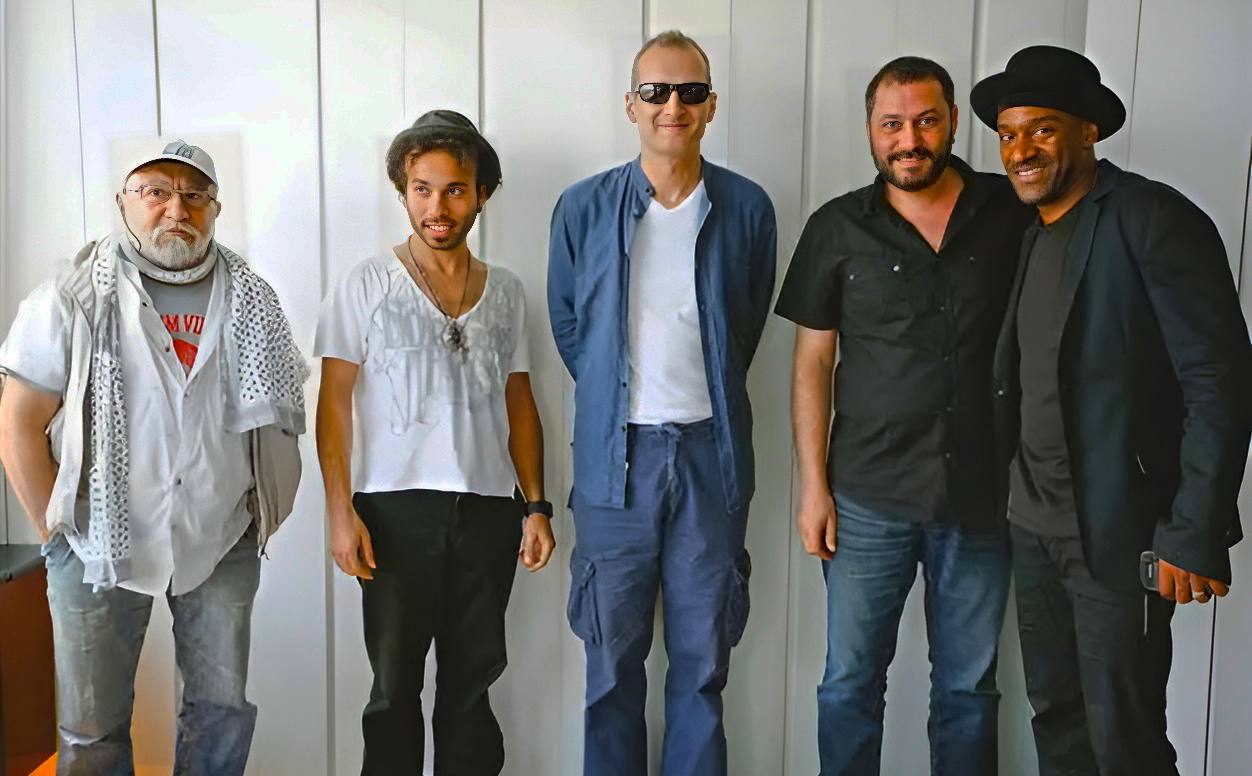 Marcus Miller's Istanbul Project, 2012: Okay Temiz, Bilal Karaman, İmer Demirer, Hüsnü Şenlendirici, and Miller | Photo: Istanbul Jazz Festival
Marcus Miller's Istanbul Project, 2012: Okay Temiz, Bilal Karaman, İmer Demirer, Hüsnü Şenlendirici, and Miller | Photo: Istanbul Jazz Festival
Another multicultural group you were part of was Marcus Miller’s 2012 Istanbul Project. How do you look back at that?
This was the real thing. It was a nice idea. It was my idea to play with Marcus at the Istanbul Jazz Festival that year and they invited him to do it. It worked very well because both Marcus and I have a lot of jazz knowledge and experience. We are very close to each other in what we do. There was none of this “Play the Turkish way” stuff with him.
Marcus used to play with Miles Davis. I met Miles when I was playing with Don Cherry once in Norway with Arild Andersen. Miles saw the show and asked Don “Who is that drummer?” Don said it’s “Okay Temiz.” Miles said “Okay, you played nice. That sounded good.” Five years later, we were in Stockholm with Oriental Wind playing in a club, which was close to a big concert hall where Miles was also performing that night. He came and saw me play afterwards. He even came up to the stage during a tune to watch more closely. When the show was over, he came and told me how much he liked it. That’s my very short Miles story. [laughs]
You have a new album titled Direct-to-Disc Sessions recorded with Islandman. Tell me how that pairing emerged and what you explored in it.
Islandman were once playing in Turkey. They make very commercial music, but they love my work very much. They asked me to do something. So, we rehearsed here at my atelier, playing my tunes. Two of the tunes on the album are mine. They also liked my electronic instruments, which I used on the album as well.
We did concerts in London and Amsterdam, and then made the recording. The recording was done live, so nothing could be changed. The album was about playing in a simple way, not in the really deep jazz way.
The group comes from another musical culture, and I’m a guest with them. There are some very clever, good, nice people in the band. I think they understood what I was giving them, musically.
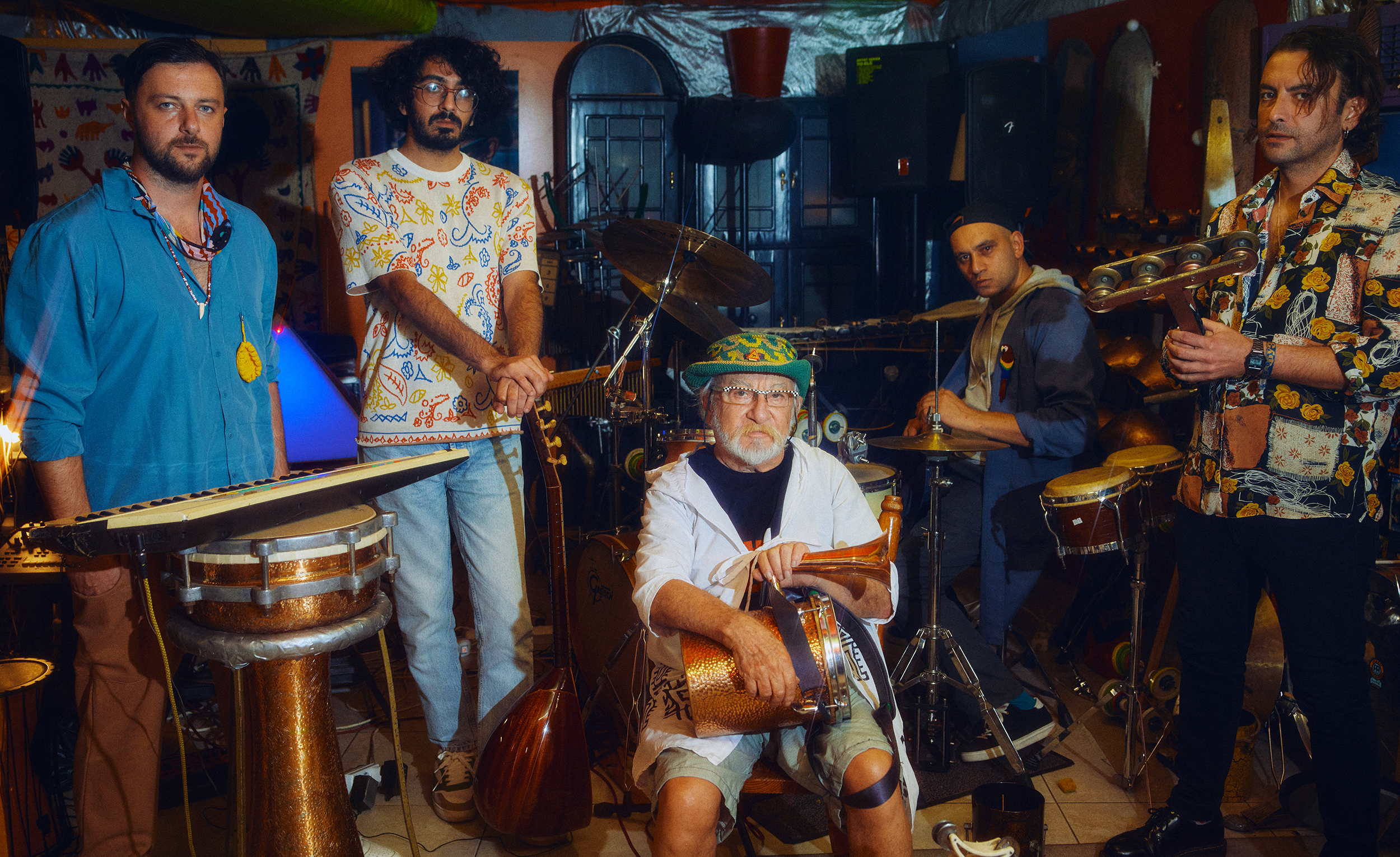 Islandman with Okay Temiz, 2022: Tolga Böyük, Muhlis Berberoğlu, Temiz, Eralp Güven, and Erdem Başer | Photo: Londonmancer
Islandman with Okay Temiz, 2022: Tolga Böyük, Muhlis Berberoğlu, Temiz, Eralp Güven, and Erdem Başer | Photo: Londonmancer
You also worked with soFa to record Şelale in 2021. What was it like to work in an electronica context for you?
soFa involves a producer and someone who uses computers to make music. The melodic composition of the music is not mine. I just made the sounds they used. They took my sounds, went home, and put this record together without my involvement. This is the way it was done. They worked very carefully to make it work for them.
It’s interesting how they make electronic music and mix it together with what I am doing. It’s a different type of electronics than what I do with my instruments. I make instruments with electronics, physically. I use motors, metal, wood, and cables. I’m really working hard to create these electronic instruments.
I’m making my own sounds through electronics, like taking a cowbell sound and altering it to get another sound. But it isn’t the machine producing the sound. I am producing the sound. That’s why my music that does use electronics sometimes is different from what these young people are doing.
The political situation in Turkey is incredibly complex, with a lot of censorship and anti-artist sentiments among the far-right government. How is this affecting musicians?
The Turkish politicians don’t help when it comes to jazz. They didn’t even accept jazz at first. Politicians are commercial people. So, the commercial pop singers get lots of support and some of them are very rich. But what about the jazz musicians and other musicians who can barely survive? Politicians should support all the different types of music, whether or not it is commercial. This is done well in other countries in Europe.
These politicians are just bureaucrats. They don’t care about musicians that aren’t commercial. They can’t even take care of the environment or the people after the terrible earthquakes earlier this year.
I have done a lot of things to try and teach politicians about the types of music I do. I’ve played for prime ministers, such as Olof Palme who led Sweden between 1982 and 1986. I performed at an event for his political party in Stockholm and we were playing unbelievably aggressive jazz. They seemed to like it, but today, it is difficult for connections like this to be made.
 Photo: Okay Temiz Collection
Photo: Okay Temiz Collection
At age 84, you’re very active and take care of yourself. Tell me about your drive to keep moving forward in your eighties.
I was born in a village. We had a thousand hectares and four tractors. My father was a pilot. They wanted to send him to fight in Korea, but he said he wouldn’t do it. So, he bought a farm. We had a small family. It was my grandfather, father, mother, and me. Typically, if you’re going to be a farmer, you have to have a larger family. We had to pay a lot of money to outside people to come work for us.
So, I’ve been physically active since I was five years old. I was on the horse pulling farm machinery at age six. I didn’t even have any shoes to wear. My background really is about the earth. Walking without shoes really puts you in touch with it.
But as I got older, I started to gain weight and decided I needed to do something about it. I changed to an organic diet. I eat organic food and drink good water. I go to the gym. I get power from all of these things. And I still get power from how I grew up.
How does spirituality influence your music?
When my parents would come see me perform, they would sit in the first or second row. My mother would say afterwards, “You never look at us during the concert.” I replied, “I don’t see anybody when I’m playing. I’m only hearing the music.” But I’m not religious at all. Neither were my parents.
There is a very big demand for Arabesque music in Turkey. I don’t play Arabesque music. I play Oriental music and jazz, with great musicians and very good rhythms. I don’t make tourist music. I’m not here to make people clap or to just entertain.
I remember when I saw Ravi Shankar perform in Turkey once. He had about 3,500 people in the audience. He and his musicians would tune the sitar and tabla on the stage, which is part of Indian musical culture. But one-third of the Turkish audience was saying “What is this? We didn’t come for this.” They didn’t want to wait—not even 10 minutes. But Indian musicians take their time and build up the music. They don’t get up to entertain people. It could a be a 90-year-old Indian musician in a wheelchair, but he’s still making incredible music. This can be very difficult for some audiences who get upset that a musician never moved their body in an entertaining way to perform.
I’m bringing this up because I’ve visited India nine times and I’ve seen how they deeply understand the importance of music and even single notes. They can make music with a single note that changes and vibrates a little bit. They don’t do that in Turkey. It’s because the audience wants the melody right away.
I am much more about the Indian appreciation for music. For me, it is only the music that matters. Music is my connection to spirituality. Notes are about vibration, and they mean a lot. They are about energy, and I believe in this energy very much.